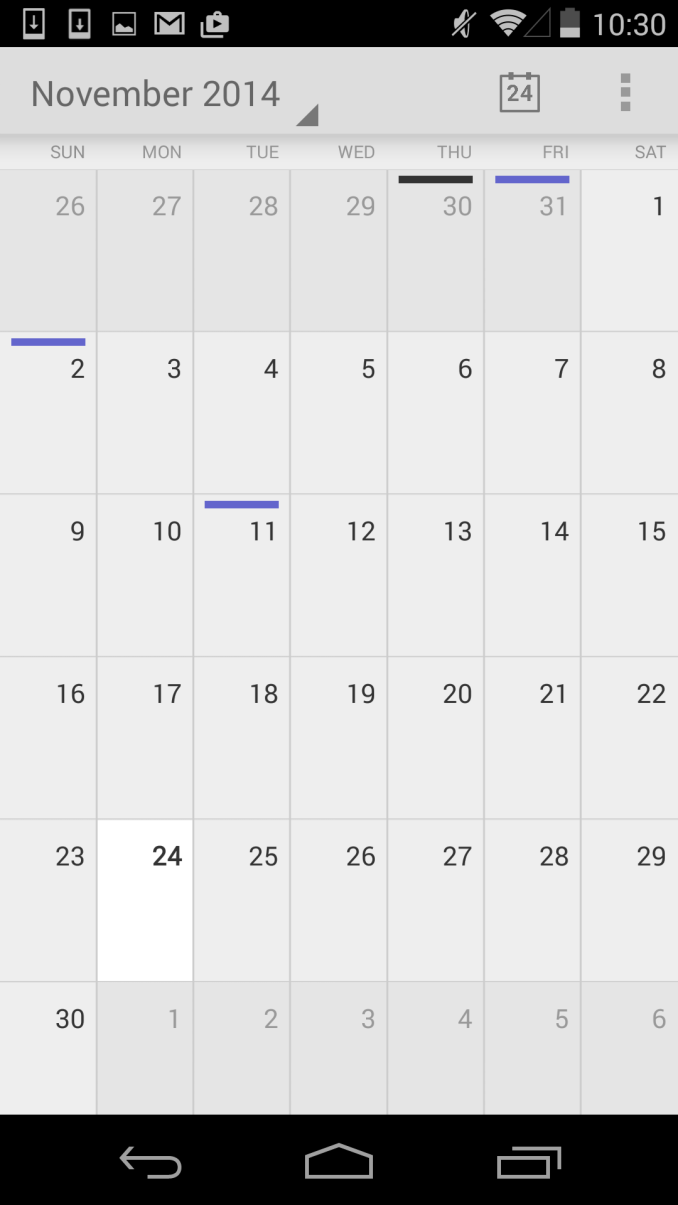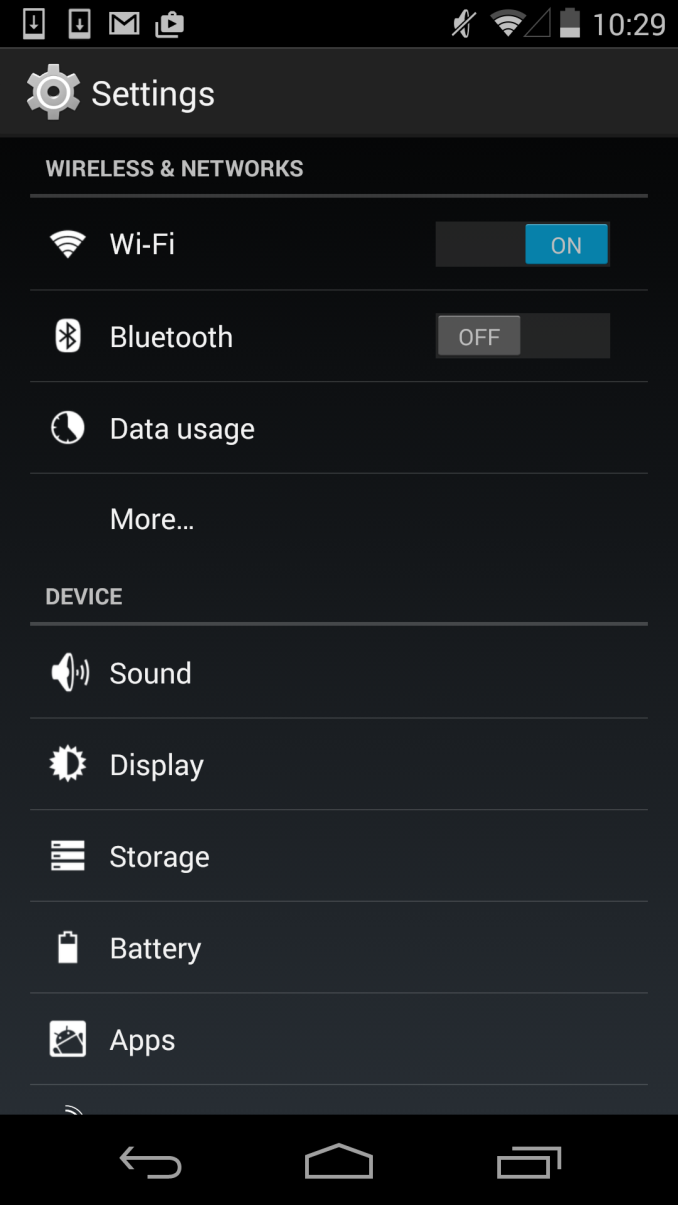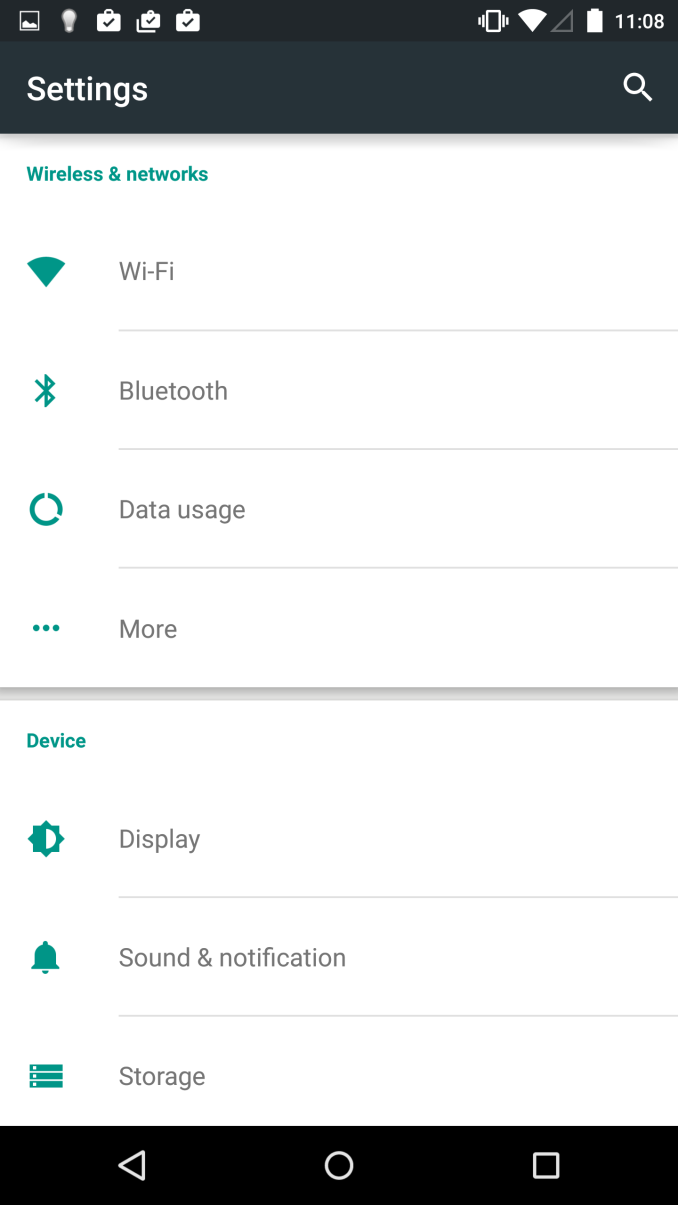The Android 5.0 Lollipop Review
by Brandon Chester on December 1, 2014 10:00 AM EST- Posted in
- Smartphones
- Android
- Tablets
- Android 5.0
Material Design
A good place to begin before discussing the operating system itself is to explain what exactly "Material Design" is. The term comes up a lot throughout the course of the review, which makes sense given how the biggest changes that users will see when moving from KitKat to Lollipop will be because of Material Design. Material Design is a set of design principles, and contained within them is something of a mission statement about Google's approach to services across multiple platforms. Material Design is definitely not Google's first big change to the Android interface, but this time I'm actually very confident that it will be the last we see for a very long time. I'm very impressed by the work Google has done to create an interface that looks and feels modern, simple, and beautiful. Before getting into what Material Design looks and acts like, I'd like to address and give my thoughts about Google's previous style of interface design which was called Holo.
To me, Holo always seemed like a transitional type of interface. Google had just brought on Matías Duarte, but as someone whose first smartphone was a Palm Pre, I didn't feel his influence anywhere at all. I think that Holo was a definite improvement over the previous Android interface, but that isn't really saying much. In my opinion, it still didn't feel coherent or look visually appealing. For example, if you showed me the two screens above without the status bar and navigation buttons, I would be hard pressed to tell you that they're from the same operating system. They don't share a single common interface element. The lack of color and use of grey was also questionable. While some users protest the heavy use of white in many modern interfaces, to me the grey that was commonly used in Holo Light applications was analogous to a dirty white cloth. The lacking color also made applications feel rather dull and lifeless, and I almost wondered if it was an effort to try and mask the fact that phones were shipping with either under-saturated or over-saturated displays by just having almost no color at all.
With my disappointment in Google's new interface, I was worried that it would just be something I would have to deal with for many years. Fortunately, less than one year after Android Ice Cream Sandwich was released, we were given a glimpse of the beginnings of a new type of design that was distinctly not Holo. It was in a feature called Google Now which launched with Android 4.1, and that many people now use everyday. This application used bright white cards to display relevant information, and had a much heavier use of color than any other applications that shipped along with Android. While at the time this could have been dismissed as the most obvious way to make an application that is constantly displaying and updating information for the user, in hindsight it was clearly the beginning of a new type of design being practiced at Google. It was still immature, lacking the animations, drop shadows, and dynamic nature of Material Design, but it began the dissolution of the Holo interface that had just been introduced.
Finally with the end of Holo, comes the beginning of Material. When Google gave a sneak peek of the new interface for Lollipop at Google IO I was very excited by what I saw seeing. The basic idea of the cards in Google Now had been applied to the entire operating system, and expanded upon in ways that I hadn't expected but have been pleasantly surprised by. As you can see above, both applications display the sections of the interface on white cards that float above the background and cast slight shadows. There's also a much greater use of color, and a better use of screen real estate by dividing the application into multiple sections which can be seen in the new Calendar application. The Settings application is actually a bad example in this regard, as the increased spacing means the main page fits less on screen than before, but this is an exception and I included it primarily to show the contrast between new and old.
Material Design is based upon the ideas of paper, lighting, shadows, depth, and color. While this sounds a lot like the skeuomorphic interface of previous versions of iOS, Material Design doesn't limit itself based on the actual limits of physical items like paper, and it doesn't go to the point where applications are merely digital recreations of real world objects. There's also a heavy use of animations. Everything you touch seems to respond with an elegant animation, and the different cards in the interface can expand, contract, and stack atop one another to create an extremely dynamic feel. It is truly hard to explain, and it's really something that needs to be used to be fully understood.
The last thing to say about Material Design is how it represents more than just a way to design applications. Like I said earlier, within Material Design is a mission statement about Google's approach to services across multiple platforms. Although I've discussed it within the context of the Android platform, Material Design is going to be what you see in Google's applications across every platform. From web apps, to Android, to Chrome, to iOS applications, you will see a consistent style of design that adapts to different display sizes, use models, and methods of input. Overall this is a great step forward in making Google's services consistent across all devices, but I think in the context of iOS applications Google may be going a bit too far by ignoring the design guidelines of that platform in favor of their own.














126 Comments
View All Comments
tralalalalalala40 - Monday, December 1, 2014 - link
iOS users welcome Android users to 2015, only 8 years late on a smooth UI!Better late than never. Consumers win!
blzd - Monday, December 1, 2014 - link
Didn't iOS just get the ability to install a custom keyboard? lol fanboys.ruthan - Monday, December 1, 2014 - link
Im still waiting for PC support - with app in window mode and multimonitor support and virtualisation and more PC HW drivers. They already have x86 build for tablets, even small 1 man project Android-x86 is now number 8 on linux distrowatch.Linux is dammed (something wrong fix it from terminal.. is show stopper for normal user) but Android could be way for good free desktop PC, users already know how to use it.
HackerForHire - Monday, December 1, 2014 - link
I was hoping for a paragraph or 2 on the improvements in low latency audio. It's unfortunate that audio always seems to be left out of the mix for most OS reviews.tuxRoller - Tuesday, December 2, 2014 - link
Look at reddit for this. Folks have adjust tested it and it still isn't usable (midi to USB).The system audio latency hasn't changed, iirc.
Regardless of I/o talks Google simply doesn't care about either audio or low touch latency.
BobSwi - Monday, December 1, 2014 - link
Didnt care for it, actually was the main factor in trying out rooting my Nexus 5. Flashed Kitkat and then Slimkat 8 in less than 2 hours from never having done it before.REBERY - Monday, December 1, 2014 - link
Odd that you would do an entire review on Android and miss arguably the single biggest improvement that this OS provides...namely, the ability for "OK Google" to be active at all times (a la Motorola). Having a personal assistant always available is a huge plus.Impulses - Tuesday, December 2, 2014 - link
Kit Kat was already halfway there with the stock launcher (post updates), you could call it up while within any app or with a locked phone if it was charging.pgari - Monday, December 1, 2014 - link
I have yet to acept the Lollipop update in my N5, as I did not like the Calendar update with its new Material Design (lost ofnow in the weekly view you see only six hours per day, forcing you to scroll)As others, I also do not like the mostly white background neither the lost of the separate keys in the Keyboard and Calculator (as shown in this review)
Brandon,
Regarding ART, you mention that it stores a pre-compilation after the first use of the application, so reducing the available storage space, but did not quantify by how much.
dblkk - Monday, December 1, 2014 - link
The more I read about lollipop the less interested I am, and the more I hope Samsung doesn't force the upgrade on my Note 4.Everything moving to white instead of black is a huge one for me. As a Note 4 owner/user, blacks are my batteries best friend, and as a 30yr old I feel black background white text is easier on the eyes, especially in a darker environment.
I also see a lot of the specific apps that are coming with lollipop are already available for download in the play store. I've tried them all, mail/calander/messanger and ive still reverted back to samsungs software. Mail is nice, but my main accounts are live and yahoo. The organization and just readability in the 'email' app are in my opinion vastly superior to inbox/mail. Messanger is nice, but I like samsungs messages just a tad better. My common's are on top of the feed, and instead of random colors assigned to people, its all custom and for me set up as a photo for each. The calendar app, I don't see much of a change, and don't care to much about. The app drawer with its transparency on kit cat are much nicer than the white background that just jumps out at you, and the notification center on my note 4 is way more easy and functional than the upgrade will be.
I haven't looked into the 64bit and performance upgrades with lollipop vs kitcat, but I have no issues at all right now, so that's I guess welcome performance boost, but not needed and not going to make me upgrade.
I do really hope that lollipop wont be forced, and if it is that this whole white theme can be brought back to dark. But honestly just don't want to upgrade.